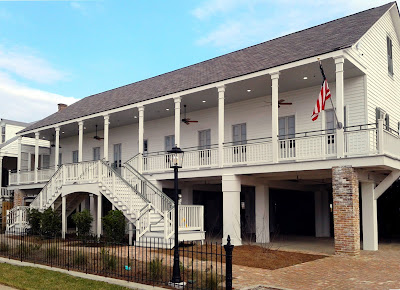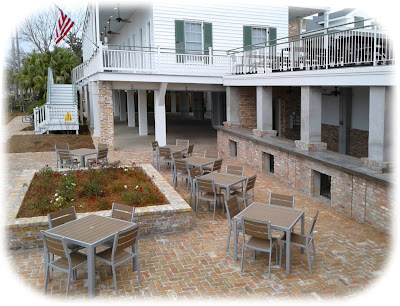This picture, taken in 2011, shows the 1986 football team from Pearl River High, back on the field for a visit in uniform.
Sunday, February 28, 2021
Saturday, February 27, 2021
Making Syrup
Nothing got family and friends together like the day at the shed making syrup. Here's a few photos of the Frank Sharp family working together to make a batch of syrup the old fashioned way.
Click on the images to make them larger.
Using a horse or mule to turn the center crank for grinding up the sugar cane was common, but as machines became improved and more reliable, they were put to use in the process. One such machine was featured in this YouTube video after it was resurrected and put back into use grinding cane for syrup. Click on the triangle to view the video.
Accommodations 1987
These were the hotels, motels and campgrounds available in St. Tammany Parish in 1987, some 34 years ago, as listed by a tourist promotion brochure.
Click on the image to make it larger.
Thursday, February 25, 2021
100 Years Ago This February 26
What was going on 100 years ago this week? CLICK HERE for a link to the St. Tammany Farmer Issue of February 26, 1921. The link is provided by the Library of Congress and its Chronicling America service.
Click on the sample images below to see larger versions.
Wednesday, February 24, 2021
Garbage Bag Full of Loot
On December 12, 1973, the News Banner ran an interesting article about a bulldozer operator finding a garbage bag in the Honey Island swamp containing several thousand dollars from a Hattiesburg bank robbery.
See also:
Gold Coins Found in Honey Island Swamp
Monday, February 22, 2021
Louisiana Avenue All Over The Place
Prior to 1917, one of Covington's busiest streets was Louisiana Avenue, a broad dirt road lined with beautiful oaks. It led from the downtown area southward towards St. Paul's and turned westward to connect up with the bridge over the Tchefuncte River that led down to Madisonville. Here's a postcard showing the thoroughfare.
Within a year, the Madisonville Road and Louisiana Avenue were greatly improved. The city of Covington , in order to show its gratitude, renamed Louisiana Avenue "Jahncke Avenue" in honor of Walter Jahncke's family who operated the shipyard and the associated navigation company that did the shell dredging.
Interestingly, a four block segment of Louisiana Avenue remains today, along the same alignment as most of Jahncke Avenue, but south of where Jahncke veers to the west and moves a block over. The current day Louisiana Avenue runs between 12th Avenue and 8th Avenue.
At the end of New Hampshire Street is "City Park," now known as Bogue Falaya Park, and just downriver from there was Ozonia, a rest home retreat on South America Street. At this point in time, Jahncke Avenue passed by St. Paul's College, although early on it was known as Louisiana Street and sometimes "Old Landing Road" since it went on down to the Old Landing.
Complications Arise
Jefferson Street, in Old Covington, which at that time ran from America Street to Jefferson Avenue, was to be changed to Jefferson Davis Street.
Madison Street, which at that time was a continuation of Theard Avenue, was to be changed to Theard Avenue from its intersection with Columbia Street all the way to Hancock Street. (19th Avenue?)
Monroe Street and its continuation known as Independence Street in the Division of St. John, stretching from the Bogue Falaya River at the foot of Columbia Street, to Seventh Avenue beyond River Glen park, was to be changed to Wharton Street, in honor of the founder of Covington.
Washington Street, in Old Covington, which at that time ran from the Bogue Falaya River to Jefferson Avenue, was changed to Lafayette Street.
And Jackson Street, in the Division of Spring, which at that time ran from New Hampshire to River Glen Park, was changed to Louisiana Street.
That's not all of the story, however. To further complicate the matter, there's another Louisiana Avenue just west of Covington, located between Pruden Road and the Tchefuncte River, that starts at U.S. 190 and heads north.
Sunday, February 21, 2021
Radio Star Performer In 1928
Byron Gautreaux of Covington became a big regional radio star way back in 1928.
Click on the image to make it larger and more readable.
Saturday, February 20, 2021
The Rest A While - Renovated
Here are several photographs of the recently renovated Rest A While complex of historic buildings on the lakefront in Mandeville. The project not only brought back to life the old hotel and retreat buildings, lifting them above future floods, but graced them with a Pat Gallagher's restaurant as well.
Click on the images to make them larger.
See also:
Rest A While History
Sans Souci
In 1905 H.P. Bougere started a creamery just off the Bogue Falaya River a few miles north of Covington in a place called "Sans Souci." It was where the Playmakers theater is today. It went on to become "one of the finest creameries" in the state.
Horace Lewis Bougere was the eldest son of Mr. and Mrs. H.P. Bougere, who have been prominent residents of Covington for the past four and a half years. He was educated in the public schools and at the Agricultural and Mechanical College at Starksville, Miss., where he obtained a thorough knowledge of the dairy and creamery business.
He was born
in St. John Parish, LA, on May 7, 1889; died in San Francisco, Cal., on
April 25, 1909. In his obituary on the front page of the May 3, 1909, Covington Daily Journal detailed the loss felt by the family and the community.
During the first two years of their residence here, he and his father conducted the Sans Souci Creamery, located on their beautiful home sight about four miles from Covington. For the past two years, he assisted his father in the dairy business, until he decided to enter the navy, leaving here only a short time since for the Naval Training Station at San Francisco, where he was fatally stricken with spinal meningitis in the very prime of his life, being only in his twentieth year.























































